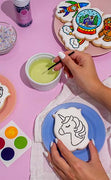
Color Theory and Cookie Decorating
Understanding the theory of color can be extremely helpful when it comes to cookie decorating. By having a basic understanding of how colors work together, how they complement each other, and how you can pair them, you can create beautiful and harmonious designs that are pleasing to the eye. Here are some key concepts you should know and keep in mind when decorating cookies.

The Color Wheel
The color wheel is a visual tool that shows the relationship between different colors. It is made up of the primary colors (red, blue, and yellow), secondary colors (green, orange, and purple), and tertiary colors (yellow-green, yellow-orange, red-orange, red-purple, blue-purple, and blue-green). By understanding the relationships between these colors, you can create color schemes that are harmonious and visually appealing.


Complementary Colors

Analogous Colors

Color Temperature
Color temperature refers to the perceived warmth or coolness of a color. Warm colors (such as red, orange, and yellow) are associated with energy and excitement, while cool colors (such as blue, green, and purple) are associated with calmness and relaxation. Temperature can be also associated with whatever emotion you are trying to express with your particular cookie design.


When it comes to cookie decorating, you can use color theory to create stunning designs. For example, you might choose a complementary color scheme (such as red and green) for a holiday-themed cookie, or an analogous color scheme (such as blue and purple) for a more calming design. You can also experiment with different shades and tones of the same color to create depth and interest in your designs.
When mixing royal icing colors, it is best to start with a white base and a small amount of icing. The best food colors to use are gel and paste food colors, since they tend to be more concentrated than liquid food colors and won’t affect the consistency of the icing as much. Remember that color will develop with time once added the icing. It may take a couple of minutes for the color to fully be absorbed, so don’t immediately add more color, or you could risk changing the consistency and taste of your icing.
When you really understand how the color wheel works, you'll find it much easier to mix colors that may have been intimidating in the past. Here's how to make a few new colors by mixing what you already have:
- Coral: Mix equal parts of Preppy Pink and Outrageously Orange gel food color to make a beautiful Coral shade. You’ll be applying the principle of mixing warm colors for a harmonious color scheme.
- Mint: Mix small equal parts of True Blue and Gourmet Green gel food color to make a soft shade of mint. Mix more or less of these analogous colors to create darker or lighter shades.
- Dusty Pink: Mix a small amount of Countess Pink and a larger amount of white royal icing with a drop of Totally Brown gel food coloring to create a dusty rose shade. This color combination utilizes the principle of mixing warm and cool colors to create a muted, vintage-inspired color scheme.

There’s an infinite amount of color combinations that can be possible when you know how to use the color wheel. Adjusting the number of drops of color added can make lighter or darker shades of the same colors, giving your creations even more depth. Experiment with different color combinations to create your own unique royal icing colors, and don't be afraid to try something new!
Shop Bestselling Colors
Recommended for You:
Piping Bag Tip Tube Covers - Set of 4
AtecoDon't let your icing bags leak or dry out! Use these covers on bags with Ateco couplers and standard tips on them. Reuse them again and again. Se...
View full detailsBlack Fine Tip Food Marker
The Cookie CountessA black edible-ink pen is essential for your decorating kit. Use these high quality markers for: Marking up baked cookies for planning designs Wr...
View full detailsStainless Steel Measuring Cups 4 Piece Set
The Cookie CountessIncredibly high quality, with no plastic parts. Whether baking or cooking you'll reach for these essentials again and again! THESE ARE THE LAST SET...
View full detailsCookie Order Form 5 x 7, 50 sheets
The Cookie CountessThese cute sheets will help you plan your cookie orders. The back has an area for sketching and pricing planning. Size: 5" x 7" 50 Sheet Pad Doub...
View full details-

Introducing the Cookie Countess Cookie Capsule Collection!
Read nowTired of using boring clear bags as packaging for your beautiful decorated cookies? Or maybe you’ve been looking for a more protective way to package them that is just as pretty as the cookies themselves? Well, look no further than...
-

Stamped Jack-o-Lantern Cookies: an Easy Halloween Treat
Read nowSo you want to make Halloween cookies, but you don't really feel like making or using royal icing? Well, do we have the design for you! Look no further than the Cookie Countess Jack-O-Lantern cutter and stamps set to help...
-

Make and Decorate Easy Mini Jack-o-Lantern Cookies
Read nowHalloween is one of the biggest cookie holidays of the year, and I personally think that can be chalked up to the sheer number of fun/spooky/adorable/creepy designs this holiday lends itself to! Let's look at one of the most basic--Jack-o-Lanterns!...














Comments
Leave a comment